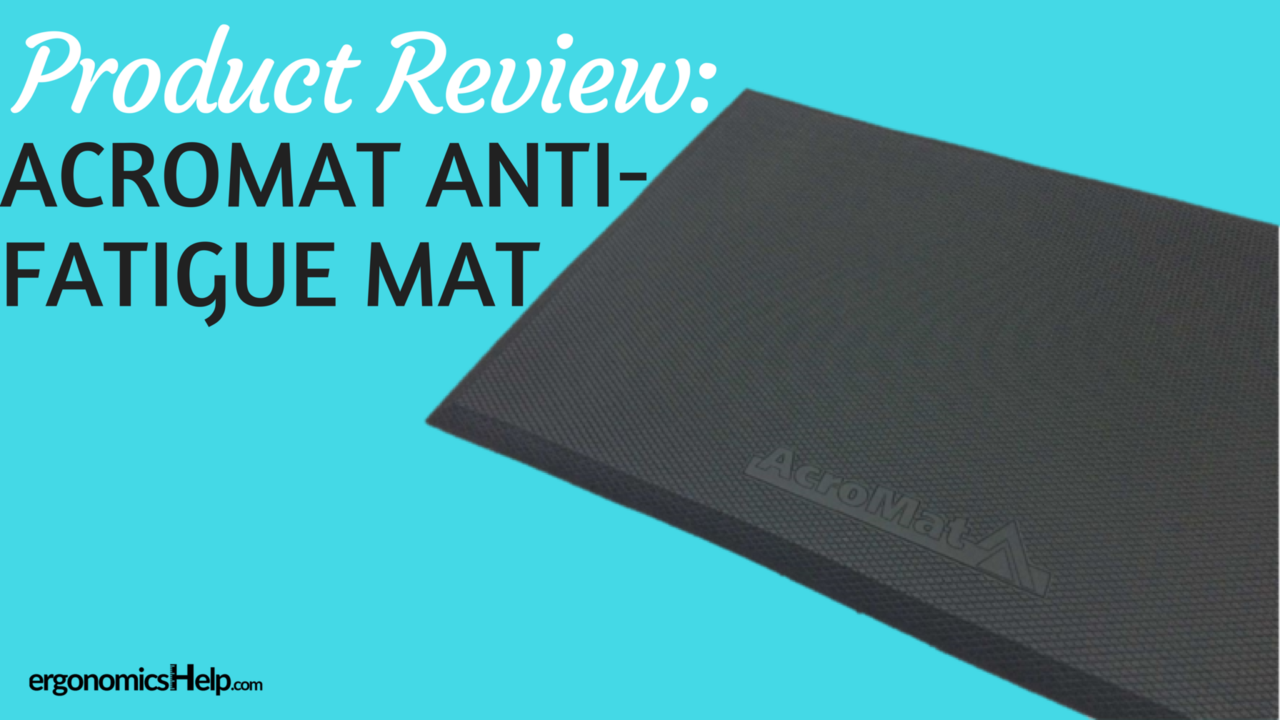Product Review: AcroMat Anti-Fatigue Mat
Sep 05, 2018
Just like peanut butter and jam sandwiches, there isn’t a better combination for a standing workstation than with an anti-fatigue mat. There are a variety of reasons why these are such a great addition to prolonged standing including that its easier on your body’s joints, most notably the lower back, and it improves lower leg blood circulation by reducing blood pooling.
But of course, there is a caveat to anti-fatigue mat use. This is a bit of disclaimer that all those who use a standing (or sit-stand) desk should know. No matter the type of anti-fatigue mat that you have, it cannot eliminate ergonomic risk if you stand for prolonged periods of time. There is substantial research showing that this can be inherently risky for a person to do. Take a look at the graphic below for some context around your standing schedule. Another word to the wise: instead of jumping into standing with your sit-stand desk, you might be better off to instead gradually increase the amount of time you stand, say over a few weeks. This will allow your body to adapt and reduce the likelihood of any aches and pains which could arise.
So I have a question for you: if you have a standing (or sit-stand) desk, do you use an anti-fatigue mat? There are a variety on the market today and in this post I am going to review one of them – the AcroMat’s Anti-Fatigue Mat.

REVIEW: AcroMat Anti-Fatigue Mat

- Robust: This mat meets the ergonomic criteria for an anti-fatigue mat in its thickness, bevelled edges, and that it’s a good size for the required task (ie: mostly standing still in one spot). Technically speaking many anti-fatigue mats on the market today will meet this criteria. But what sets this mat apart is that it is quite robust to stand on, it holds its shape very well. This means that after standing in one location for awhile the mat doesn’t flatten and doesn’t require you to relocate your feet to get cushion and relief.
- Good For Long-Term Standing. This is where quality anti-fatigue mats really shine when compared to cheaper models or even using something else that is soft to stand on, like those bright tiled mats that you would frequently see in a toddler’s play area. In my experience it may seem like you are saving money by buying a cheaper mat but in the long-run cheaper mats affect the standing experience. It’s similar to the idea of buying a quality pair of running shoes if you are a frequent jogger; a pair of loafers will not give you the foot support required to run long distances. The same is true with investing in good a quality anti-fatigue mat for a standing desk.
- Good Balance. A good anti-fatigue mat will have a good balance between enough cushion and instability and such is true with this mat. Remember there needs to be enough cushion to be comfortable for our joints yet have enough of an unstable surface to activate the venous pump (required to improve lower leg circulation). Mats with too little instability will likely not activate the venous pump. On the other hand mats with too much instability would likely be extremely fatiguing to stand which could affect concentration at work.
- Reasonably Priced. The cost of this product is under $100, which is quite reasonable for the marketplace. Often anti-fatigue mats of a similar quality would be priced well over $100.

- Slide-Ability: This is a general concern when working with anti-fatigue mats and sit-stand (or standing) desks. Anti-fatigue mats are not designed to have a chair sit on top of it so the mat must be physically moved when the user wants to go from standing to sitting (or vice versa). Depending on the type of flooring that you have in your office it will effect how easily the anti-fatigue mat can be moved between sitting and standing periods. In an ideal situation you would only need to slide the anti-fatigue mat along the ground to make space for the chair, as this would eliminate an awkward body position. With this type of anti-fatigue mat it is very simple to move on wooden or tile floors, but if you have carpet, then you will have to lift that anti-fatigue to move it. This is more of an inconvenience than anything.
- Slightly More Difficult To Clean. During my review period I noticed that paper, dirt, dust etc tended to stick to its surface. This definitely is not a deal breaker, although it is good to be made aware of.

AcroMat offers one of the better anti-fatigue mats that I have tried on the market today. From a ergonomic specification standpoint all the typical requirements are met and surpassed. Lets talk about its longevity. I have only used this anti-fatigue mat for a couple of months so unfortunately I cannot comment on the long-term wear and tear and how it will hold up. I did contact the manufacturer and the industry standard for anti-fatigue mats is between 3 to 5 years to put this review in context.
ONE LAST THING. Remember that anti-fatigue mats work hand-in-hand with standing (or sit-stand) desks; they entice employees to use their standing desk more often throughout their workday because it adds value to the employee experience. Considering the high cost of a standing desk, adding an anti-fatigue mat (at a fraction of its cost) should be a no-brainer to encourage their use.
Disclaimer: Acromat sent me this mat specifically for a review, although they did not pay to do this.
